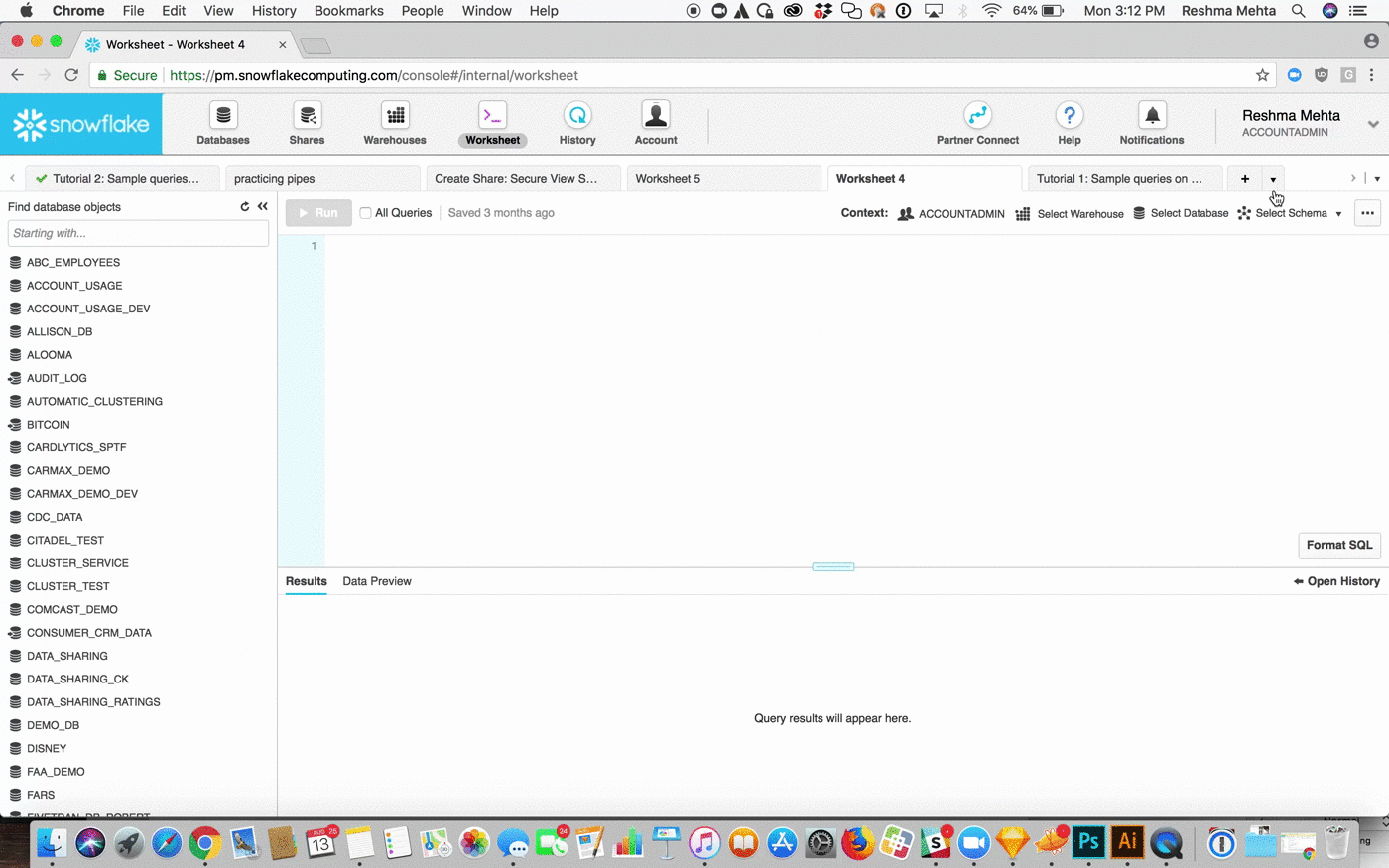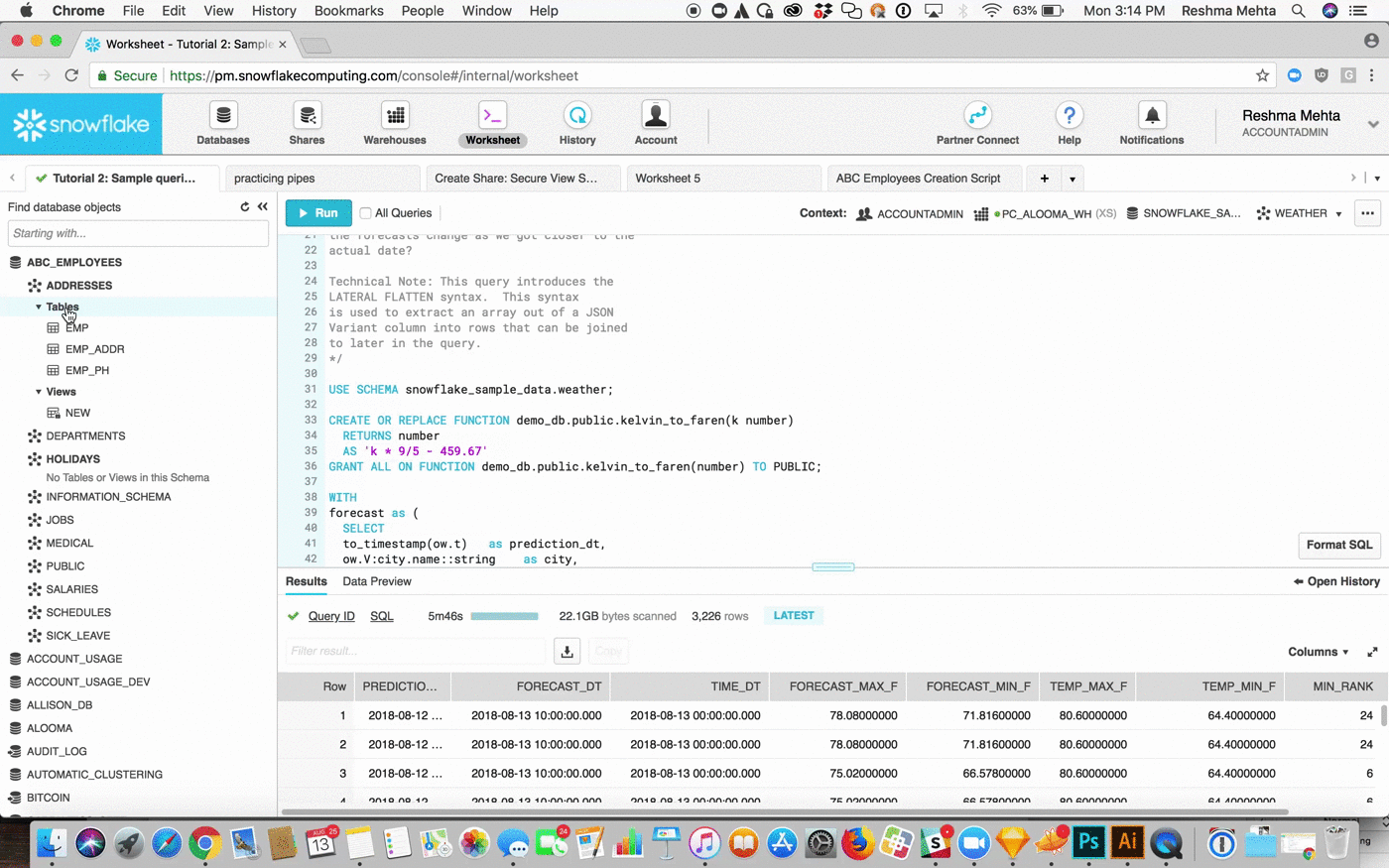We’ve been working diligently on product updates to make the lives of DBAs, Data analysts and BI professionals easier. Worksheets, Snowflake’s SQL editing tool, has been completely redesigned and is now available through our Web-based UI. This new update sets the groundwork for future enhancements over the coming months.
Why We Improved Worksheets
Looking to transform the user experience, we started this journey in 2017. We envisioned a sophisticated SQL editing tool that would assist DBAs by simplifying complex query construction so it would ultimately help business teams quickly gain valuable insights from their Snowflake data.
To set the foundation for a new, refreshed design that incorporates interaction patterns aligned closely with a developer’s workflow, we spoke with numerous customers to understand their workflows, pain points and desired outcomes.
From our conversations, it was clear that users saw the advantage of using a tool that allowed them to seamlessly interact with their Snowflake databases, such as navigating the object hierarchy, choosing roles to work within their RBAC model and managing their virtual warehouses. While our old web UI was feature-rich, it fell short on delivering on our commitment to the user experience by requiring users to toggle between the Worksheet and Databases tabs to find objects they wanted to reference in their SQL queries.
New Enhancements
We identified and addressed 3 common areas for improvement:
- Performance and stability
- Improved usability
- New features
Performance and stability
Because customers support business-critical operations by creating and maintaining various worksheets for troubleshooting, analysis, management and administration of their data warehouse, it is imperative that the interface is stable.
To address stability, we re-wrote a majority of the codebase for the Worksheet UI. Worksheet encryption/decryption is now optimized with file compression for faster loading and saving. In addition, we’ve introduced worksheet persistence in the cloud and robust conflict resolution so that you never lose a line of code. Our ReactJS-based results grid was adopted for its superior performance when rendering millions of records or thousands of columns. It was also customized to offer the features that are required for manipulating results in a data grid.
Usability
Users often reported frustration with the limit on the number of open tabs, difficulty in finding saved worksheets and confusion with common actions such as closing a tab or encountering limited space for writing code or analyzing results.
To address these concerns, we gave worksheets a refreshed look and improved ergonomics. Previously users were only able to open 6 worksheets, but they can now open up to 50 worksheets and manage them more comfortably. With a flexible layout, customers can increase the size of the SQL Editor when writing SQL statements or maximize the Results pane when analyzing results. In addition, Worksheets allows users to expand or collapse the Query History and resize the pane if needed so they can quickly decide what information they want to see.
When analyzing results, users can resize result columns by double-clicking their right edge, or hide certain columns from the query results before exporting to a flat file. The best part of these flexible UI enhancements is that any changes made to a worksheet tab are persisted as users move between worksheets.
Visual refinements along with consistent interaction patterns and components have significantly improved usability. For example, when setting the context for a specific worksheet, dropdowns to select a role, warehouse, database and schema are typeahead components so you can quickly find what you are looking for.
New Features
Manage your Worksheets:
You now have the ability to search for worksheets, rename them and open or delete multiple worksheets at once.
Searchable Object Browser, Data Previews & Table Schemas:
Snowflake’s Object Browser is designed for exploration and finding specific objects in a database. Search any database, schema, table or view and continue to explore within your search results.
Double-click to insert a fully qualified object name into the SQL Editor or set a database and schema as your default (i.e., set the context) so you don’t have to make a fully-qualified named reference to specific tables or views in your SQL code.
View the schema of a table or view as well as its cluster keys, size and number of rows. The Object Browser shows the list of columns and their data types in a pane that slides up when you click on a table or view name in the Object Browser. From there you can generate a data preview if you like.
Collapse the Browser if you don’t need it and reclaim space for SQL editing and result analysis.
The Value of Worksheets
After many demos and check-ins with internal stakeholders and engineers who use the Worksheets, we progressed to the new UI at an incredible pace, with an extensive public preview period of testing and bug fixing. We envisioned a sophisticated SQL editing tool that would assist both DBAs and business teams with their respective workloads using their Snowflake data, and we think we’ve succeeded.
But don’t take our word from it. Happy customers have expressed their delight with Worksheets for its robust capabilities:
“The new Snowflake Worksheet removes the need for third-party tools to work within the platform — including all administrative operations, most SELECT queries, and any type of explorative work — and makes working within the Snowflake environment even more seamless.” – Nick Elser, Director of Engineering at Instacart
And last, but not least, all of this was made possible because of you. The insights you’ve provided have given us the information we needed to improve Worksheets. Be sure to follow us on @snowflakeDB to learn more.
Take advantage of our $400 worth of free usage (compute and storage) for 30 days.



